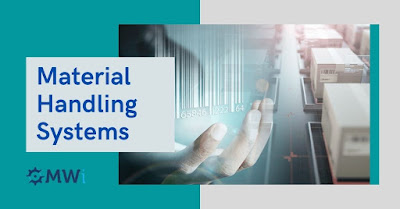Material Handling Systems Expounded - MWI Solutions
To determine what material handling is specified for and what domain it falls under and what are the objectives of material handling systems, we need to initially understand the following i.e. what are the types of material handling systems along with a classification of material handling systems.
Each and
everything involved in a product to be manufactured, shipped, outsourced, put
on the showroom display, or market for sale go through series of selection of
material handling systems. Overall material handling systems and their related
stuff falls under the gigantic umbrella of the Supply Chain Management process.
To get going on the material handling systems we first need to know how the
supply chain works.
To be very
precise, the supply chain along with material handling systems ensures
efficiency and productivity in the overall consumer and supplier
relationship. Material handling moreover
keenly focuses on moving the product after the manufacturing and ensuring the
security, reliability of the product till the product is delivered to the
customer or moved to the destined place.
All the
cycle from the production, manufacturing, delivering, and consuming comes under
the banner of the supply chain and whereas all the contrivances and protocols
used for the completion of the cycle fall under the whole material handling
system thing. This means the supply chain is the route of all the products
being handled by the companies all around the globe and the material handling
systems on other hand are its helping components that make sure the success of
everything from production to delivery.
Material
handling is one of the most important parts of logistics operations. The utmost
importance inside the domain of material handling is given to the design of the
material handling system. This is because the design of the whole material
handling system determines how effective and efficient the overall movements of
the system are according to the type of product for which they are deployed.
The design depicts the overall layout and helps the engineers to develop the
tools and pivot points that can maximize the output and minimize the effort as
much as they can.
Three basic
mechanisms are given full attention while designing a material handling system
and that are following:
1. Unit Load Concept
2. The In-process handling
3. Distribution
Unit Load Concept refers to the items being treated as a single component and they are handled, manufactured, shipped, and deployed separately. The scenario is different for the liquid products, gas, or grains in their form but there one big chunk or a piece in bulk is considered as a single unit.
· In
the In-process handling phase weight, height, size, etc. is constituted of the
unit defined earlier in the phase. This is mainly relating to the physical
movements based on the design partition of the product. The heavy chunks of
loads are further divided and carried separately to ensure the safety of the
products and the handlers working as well.
· The distribution phase covers the delivery of the product that is handled as a single bulk component. The distribution phenomena can be way much different for the products according to their size and shipment scenario and are facilitated accordingly.
Material
handling systems fundamentally are of two types that are:
1. Manual Material Handling
Manual type of handling involves physical men and laborers working with their hands ensuring the movement of loads and items in the material handling system.
2. Automated Material Handling
Automated
type of handling is the kind of handling in which industrial equipment and
machines are used for handling the products.
The most widely used type is the hybrid one
and equipment is used with help of human operators for most of the work.




Comments
Post a Comment